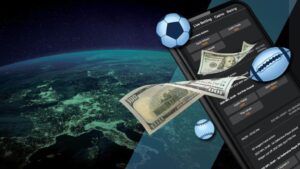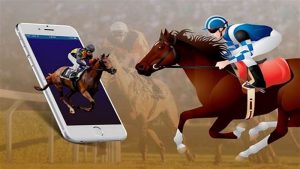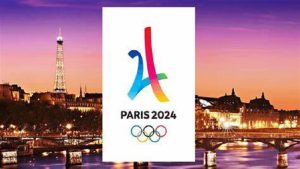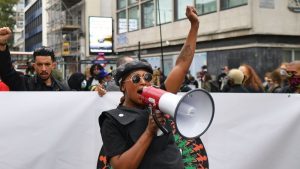
text by Kevin Seal
photographs by Jonathan Pirro
–
“If at first you don’t succeed, call an airstrike.”
– projected text from Roger Waters: The Wall at AT&T Park, 5/11/12
Roger Waters, the stadium-rock showman and concept-album auteur who quit the band Pink Floyd nearly thirty years ago, has brought his epic, expensive production of that band’s 1979 album, The Wall, back for another round of performances. This time, however, the show has taken on a decidedly more political bent.
For a generation of rock fans like myself, The Wall was a landmark album whose importance could not be overstated. Throughout the ’80s, while our hipper and less sheltered peers were digging into hip hop and metal, we suburban white guys tended to obsess over the more establishment-friendly arena rock of Pink Floyd and The Wall. We watched the movie starring Bob Geldof, we pored over its lyrics for symbolism and referentia, and our classic-rock radio stations made “Another Brick in the Wall (Part Two)” a hit. Its refrain, “We don’t need no education / We don’t need no thought control,” transformed into a mantra. It was an oft-cited and oft-misunderstood scream of anti-establishment fury and rebellion, played on the same establishment radio stations that were pumping REO Speedwagon, Foreigner and Bob Seger.
For young rock listeners looking for deeper meaning, the lure of The Wall was strong. Themes recurred and morphed over the course of the four album sides, as characters appeared and returned. Like Tommy, Quadrophenia, The Rise and Fall of Ziggy Stardust and the Spiders From Mars, and other Big Concept Albums that came from the UK, The Wall had resonance and significance where other albums were just collections of songs. The Summer of Love had Sgt. Pepper, while the summers of fear, greed and disillusionment (aka the Reagan-Bush era) had The Wall.
(please also read photographer Jonathan Pirro’s own review of this show at Spinning Platters.)
The crowd at San Francisco’s AT&T Park on Friday night was comprised, for the most part, of folks who look like me. It seemed like a lot of white guys from the suburbs; sure, there were female fans too, but for the most part this seemed like a WASP-y classic rock dudefest.
I mention race, gender and religion here because these distinctions are not only relevant to the album itself and its attendant film and stage productions, but because Roger Waters has come out as a vocal supporter of the Occupy movement (see video below). Waters is using his white privilege — and more dramatically, his privilege as a famous millionaire — to encourage participation in Occupy and its varied offshoots.
“I pay taxes here,” says Waters, now a resident of the United States, in the “Roger Waters – Occupy” video. “I’d be happy to pay more. I’m with Warren Buffett, and I think it’s great that people are beginning to complain about it. I mean, I can’t believe that people didn’t start complaining after the mortgage swindle.”
The video includes a live recording of Waters and his band playing “Mother” on the new tour of The Wall. In its original context, “Mother” is ostensibly about a domineering mom who shelters her son from temptation, and in doing so, screens his girlfriends so that she “won’t let anyone dirty get through.” (You can see why this record resonated so deeply with teenage boys.) In the revamped, more politicized, less personal 2012 version of The Wall, however, Waters makes it clear that Mother is a stand-in for Big Brother and government surveillance.
The line from that song, “Mother, should I trust the government?” is now its pivotal lyric. It’s the only line in the song to earn a giant text response on the massive projection screen — which happens to be the largest projection screen in concert history. As soon as Waters sings the line, a blood-red slash of text in the “Wall scrawl” font splashes across: “NO FUCKING WAY.”
It’s heavy-handed, certainly, but The Wall has always been about broad strokes. At the time of its release, the album was a commercial success but a critical failure. Many critics accused Waters of narcissism, and of using the rockstar megaphone as a tool for solipsistic self-analysis; others railed against the vilification of female characters (his controlling mother, his deceitful wife, the dopey groupie) as misogynistic. In the politicization and re-interpretation of his most well-known work, Waters tempers some of these perceived flaws. The character of the Wife now sings in a distinct German accent, driving home the point that The Wall is not about Waters any more — this is agit-prop theater writ large in massive arenas. In this gargantuan stadium where the San Francisco Giants usually play baseball, the audience is now digging into geo-politics.
In years past, Waters has described the night which inspired The Wall. Pink Floyd were on tour, and in the middle of one of these monstrous mega-arena shows. As the band went into a quiet moment between blares of bombast, Waters hoped to bring the music’s volume down. It was a moment for dynamics and breath in which he was attempting subtlety. An audience member in front chose this moment to start screaming the classic concert cheer — “WHOO-HOOOO!” — at which point the famously grumpy bassist-singer snapped. Waters spat at the fan.
After the show, Waters was despondent. What have I come to? Why would I hate a fan of my music? How do I feel so separated from the people who support me? Aren’t I trying to connect with that listener? That soul-searching over his alienation inspired an 80-minute story about a boy whose soldier father dies in World War II — just as his own father died when Waters was only five months old.
(the chorus of schoolchildren all wore shirts printed with the phrase, “Fear Builds Walls.”)
The autobiographical links don’t go much further than the deceased father. The character in the album becomes a famous rock musician (well, okay, there’s that), and various events and people in his life become “bricks in the wall” that he constructs around himself. His alienation deepens through a failed marriage as he spirals into depression. Eventually, this character loses his grip on reality, and in the finale he envisions a trial in which his mother, his wife and his former schoolteacher testify against him. The judge rules in their favor, insisting that this man must be punished. The bench issues the heftiest punishment imaginable, and that sentence is “to be exposed before your peers. Tear down the wall.”
A key pair of songs are given added weight in Waters’ new staging. “In the Flesh?” and “In the Flesh” share similar musical backing but feature different lyrics. “In the Flesh?” opens the show, and shows the rock star revealing that this is all merely an act. He is a disguised performer on a stage, acting out a script. Much later in the show, “In the Flesh” finds this megalomaniac at his worst. He has devolved into an anti-Semitic, racist, homophobic bigot, and he calls for a spotlight to find various undesirables in the audience: “That one looks Jewish, and that’s one a coon / Who let all this riffraff into the room? / There’s one smoking a joint, and another with spots / If I had my way, I’d have all of you shot.”
By that point, Waters’ character (in the film, Bob Geldof’s character) is done up in black leather and jackboots, with red armbands reminiscent of those found on a Nazi uniform. The character is losing his humanity, and here he reaches his moment of bottoming-out.
For the latter-day staging, a black inflatable pig appears for “In the Flesh.” The pig is a staple of Pink Floyd concert absurdity, and it refers to the songs “Pigs on the Wing 1,” “Pigs (Three Different Ones),” and “Pigs on the Wing 2″ from their 1977 album, Animals. The longest and most pointed of these songs, “Pigs (Three Different Ones),” features a full-frontal attack on the queen of UK censorship during the mid-1970s, Mary Whitehouse. On the whole, however, these pigs — in lyrics as well as in the stage show — stand in as a symbol for Fascism.
The inflatable pig of 2012 has a variety of symbols all over him: the hammer and sickle of the Soviet Union, the Star of David (Waters announced his public support of the Palestinian BDS movement late in 2011), a variety of graffitied messages, and, winkingly, the capitalist slogan of “Buy Kalashnikov Vodka.”
As the music and lyrics are largely unchanged from the 1979 album, it’s the extravagant light show and these stage props which most set the new production apart. Some of Gerald Scarfe’s animations from the 1982 film are featured on the projection screen, but Waters has spliced in more modern references: John Pike, the pepper-spray cop from the UC-Davis Occupy Wall Street protests; the famous Wikileaks video of a US air crew shooting Iraqi civilians; new animation of jets unloading payloads of red ideological symbols, carpet-bombing the landscape with Christian crosses, Muslim crescent moons and stars, McDonald’s logos, dollar signs, etc.
Projected along the wall — the literal gigantic wall that forms a barrier between the band and the audience as the show continues — is a series of fake political posters showing a graphic often associated with the work: two black-and-red perpendicular hammers encircled on a white-and-red background, against a field of red. At the bottom, each poster reads “Trust us.” At the top, above the row of posters, the same white font displays the word “Capitalism.”
So, does this show have a happy ending? Yes and no. After the judge decrees that the wall must be taken down, and the massive white bricks tumble down, the band walks to the front of the stage and plays an acoustic song which ends the album, “Outside the Wall.” In this plaintive ballad, reminiscent of an ancient Irish melody, “the bleeding hearts and artists make their stand.” The main character is the Everyman, and his allies, these lefty artist types, have been pacing around outside the wall, waiting for it to tumble. As always, and as with all of us, “it’s not easy banging your heart against some mad bugger’s wall.”
The move on Waters’ part to recast The Wall as a political allegory underscores two primary themes that were present but less obvious in the original album: resistance to fascism, and resistance to war. At Friday’s show, the pre-show and lengthy intermission featured projections of facts and photos. The images were of people who died in wartime — not just soldiers and sailors but civilians, activists and others — accompanied with the facts of their deaths. This is now an anti-war show, through and through.
Seeing those faces, and reading the facts surrounding their early deaths, hit much harder than the more glib sloganeering the production occasionally hit upon (“Stop Wars” written in the style of the “Star Wars” logo, as one example). By bringing to light those individuals whose sons, daughters, spouses and friends lost them to acts of terrorism and war, Waters has transformed what was once the self-centered screed of a nihilistic rock star into a very moving piece of political theater.
Here are the 2012 tour dates for this show, courtesy of RogerWatersTours.com:
May 01, 2012 Houston, TX Toyota Center
May 03, 2012 Austin, TX Frank Erwin Center
May 05, 2012 Tulsa, OK BOK Center
May 07, 2012 Denver, CO Pepsi Center
May 11, 2012 San Francisco, CA AT&T Park
May 13, 2012 San Diego, CA Valley View Casino Center
May 15, 2012 Phoenix, AZ US Airways Center
May 19, 2012 Los Angeles, CA TBA
May 22, 2012 Portland, OR Rose Garden
May 24, 2012 Seattle, WA Key Arena
May 26, 2012 Vancouver, BC BC Place
May 28, 2012 Edmonton, AB Rexall Place
May 31, 2012 Winnipeg, MB MTS Centre
June 03, 2012 St Paul, MN Xcel Energy Center
June 05, 2012 Detroit, MI Joe Louis Arena
June 6, 2012 Grand Rapids, MI Van Andel Arena
June 08, 2012 Chicago, IL Wrigley Field
June 10, 2012 Louisville, KY KFC Yum! Center
June 11, 2012 Indianapolis, IN Conseco Fieldhouse
June 13, 2012 Atlanta, GA Philips Arena
June 15, 2012 Ft Lauderdale, FL BankAtlantic Center
June 16, 2012 Orlando, FL Amway Center
June 19, 2012 Nashville, TN Bridgestone Arena
June 21, 2012 Buffalo, NY First Niagara Center
June 23, 2012 Toronto, ON Rogers Centre
June 25, 2012 Ottawa, ON Scotiabank Place
June 26, 2012 Montreal, QC Bell Centre
June 28, 2012 Albany, NY Times Union Center
June 29, 2012 Hartford, CT XL Center
July 01, 2012 Boston, MA TBA
July 03, 2012 Pittsburgh, PA Consol Energy Center
July 6, 2012 New York, NY TBA
July 09, 2012 Raleigh, NC RBC Center
July 10, 2012 Charlotte, NC Time Warner Cable Arena
July 12, 2012 Washington, DC Verizon Center
July 14, 2012 Philadelphia, PA Citizens Bank Park
UPDATE: After this article went to press, a CBS News program, 60 Minutes, aired a feature on Roger Waters, which is viewable here. A downloadable clip of that Waters interview is available as well.







